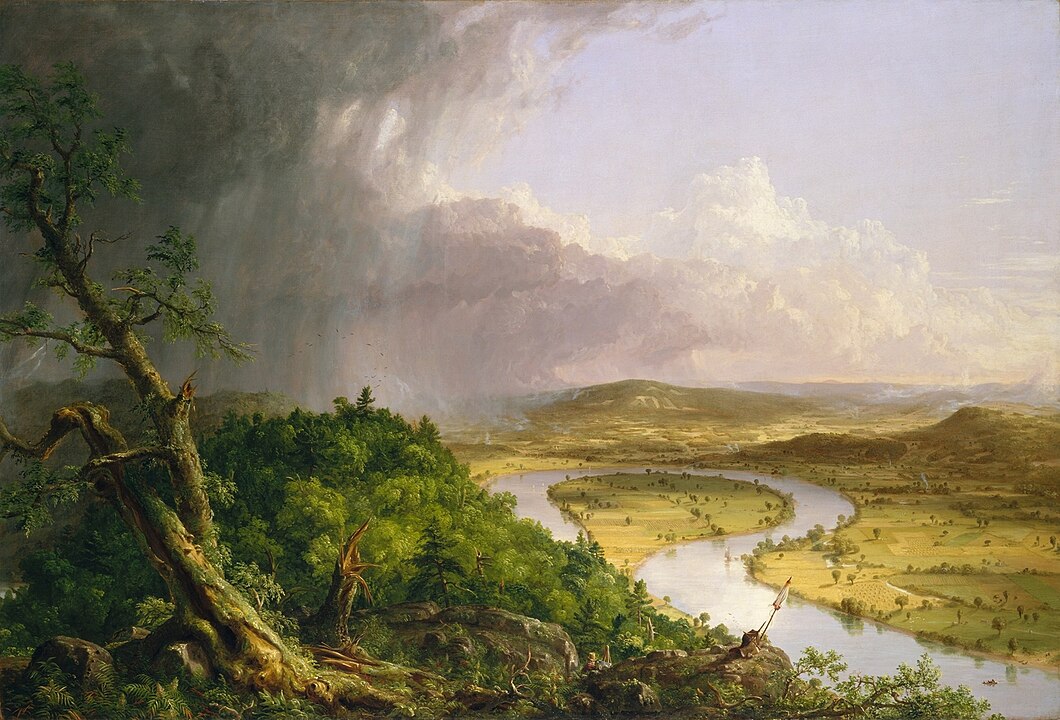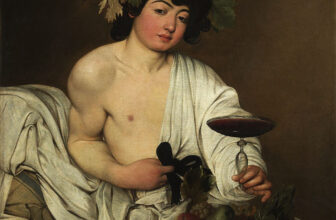
The Oxbow Painting by Thomas Cole: A Deep Analysis and Meaning
Thomas Cole’s The Oxbow (officially titled View from Mount Holyoke, Northampton, Massachusetts, after a Thunderstorm) is one of the most iconic masterpieces of 19th-century American art. Painted in 1836, it not only embodies the grandeur and tension of the American landscape but also offers a rich tapestry of symbolism, political commentary, and spiritual reflection. This 2,000-word analysis delves into the deeper meanings of the painting, exploring what is happening in the scene, its symbolic interpretation, artistic style, and its present-day location.
1. Overview of The Oxbow
At first glance, The Oxbow presents a sweeping panorama from Mount Holyoke in western Massachusetts, overlooking a bend in the Connecticut River. The painting is divided almost symmetrically into two contrasting halves. On the left, a dramatic thunderstorm brews over a wild, untamed forest. On the right, a serene, pastoral landscape unfolds, showcasing cultivated fields, a winding river, and distant hills. This visual dichotomy is the key to unlocking the deeper meanings of Cole’s work.
Painted during a period of intense political and social change in the United States, The Oxbow serves as both a celebration and a warning. It reflects the ideals of Manifest Destiny while cautioning against the unchecked exploitation of nature. The painting was exhibited at the National Academy of Design in 1836 and received immediate acclaim.
2. Historical Context and Artistic Background
Thomas Cole was the founder of the Hudson River School, a group of American landscape painters who drew inspiration from Romanticism and the sublime beauty of the American wilderness. Born in England in 1801 and emigrating to the U.S. in 1818, Cole brought a European sensibility to his depiction of American scenery. He was acutely aware of the rapid industrialization and westward expansion that characterized early 19th-century America.
By the 1830s, the young United States was grappling with issues of identity, land use, and cultural development. Cole’s paintings often wrestled with these themes, portraying nature not just as scenery but as a moral and philosophical subject. The Oxbow is a culmination of these artistic and ideological concerns.
3. Composition and Visual Elements
Cole’s composition in The Oxbow is deliberate and calculated. The painting is structured to contrast two worlds:
- The Left Side (Wilderness and Storm): This side is dark, chaotic, and foreboding. Towering trees, broken branches, and steep mountains evoke the sublime , a concept popularized by Edmund Burke that describes the awe-inspiring power and terror of nature. Lightning has struck, and a storm looms ominously.
- The Right Side (Civilization and Calm): This side is bathed in sunlight, orderly, and peaceful. The oxbow-shaped river curves gently through well-tended fields, suggesting human mastery over nature. Farmhouses, cultivated rows, and distant hills convey prosperity and harmony.
A small figure near the center of the painting, nestled among rocks and painting on a canvas, is often interpreted as Cole himself. This self-portrait implies his role as an observer and commentator, bridging the divide between nature and civilization.
4. Symbolism and Deeper Meaning
The power of The Oxbow lies in its rich symbolism and layered meanings:
- Nature vs. Civilization: The clearest symbolic tension is between the untouched wilderness and the domesticated land. Cole is highlighting the duality of the American experience: the untamed frontier and the promise of progress. This juxtaposition prompts viewers to reflect on the costs and benefits of expansion.
- The Storm and the Light: The transition from storm to sunlight may symbolize divine providence or the idea of Manifest Destiny. The storm clouds parting could represent the American belief that expansion was both inevitable and ordained by a higher power.
- Hebrew Letters: A fascinating detail often missed by casual viewers is that the deforested hills on the right spell out the Hebrew word “Noah” when viewed upside down. Scholars debate the intent, but it may reference the biblical story of renewal after destruction, reinforcing the theme of rebirth and transformation.
- The Painter: Cole painting within the painting symbolizes the artist as mediator, someone who interprets nature for society. It also emphasizes Cole’s personal stake in the landscape and his awareness of the environmental changes happening around him.
- Moral Undertones: Cole was deeply concerned about deforestation and the encroachment of industry. The painting may serve as a cautionary tale, urging viewers not to forsake the wild and spiritual aspects of nature in pursuit of economic gain.
5. What Is Happening in the Painting?
The Oxbow captures a moment of transition , both meteorological and metaphorical. A storm has passed (or is passing), and the sun is breaking through. This transitional moment mirrors the state of the American landscape in 1836, poised between wilderness and civilization.
The scene is static, yet dynamic in implication. Trees have been felled, fields plowed, and land subdivided. Meanwhile, the storm over the mountains suggests that not all change is peaceful. The viewer is left to ponder: Will civilization bring order and prosperity, or will it destroy the very wilderness that defines the American spirit?
The inclusion of the painter (Cole) creates a meta-narrative. He is not only capturing the scene but participating in the act of creation and documentation. It invites viewers to consider the role of art in shaping cultural consciousness.
Style and Artistic Classification
The Oxbow is a quintessential example of Hudson River School painting, a style characterized by:
- Emphasis on natural landscapes
- Use of light and shadow to convey emotion and narrative
- Attention to detail and realism
- Romantic and sometimes spiritual overtones
The Hudson River School was influenced by Romanticism, particularly the works of European painters like J.M.W. Turner and Caspar David Friedrich. However, Cole and his followers imbued their landscapes with a uniquely American identity, treating the land as both a subject and a character.
Cole’s use of the sublime and the pastoral in The Oxbow demonstrates his mastery of Romantic techniques. The painting is not merely a realistic depiction; it is an idealized and moralized vision of the land
The Painting’s Legacy and Current Location
Today, The Oxbow is housed in the collection of The Metropolitan Museum of Art in New York City. It remains one of the most studied and revered works in American art history.
The painting has inspired generations of artists, environmentalists, and scholars. Its themes remain remarkably relevant in the context of modern debates over conservation, urbanization, and climate change.
The Oxbow is often cited in discussions of American identity, reflecting the nation’s complex relationship with its natural environment. It also holds a place in educational curricula as a prime example of 19th-century landscape painting and American Romanticism.
Thomas Cole’s The Oxbow is far more than a picturesque view; it is a profound statement on the American condition. Through its dramatic contrasts, symbolic elements, and philosophical underpinnings, the painting explores the tension between nature and civilization, chaos and order, the wild and the cultivated.
As an artist, Cole was deeply invested in the moral and spiritual dimensions of landscape. In The Oxbow, he presents a vision that is both beautiful and thought-provoking, encouraging viewers to reflect on their place within the broader environmental and cultural landscape.
Almost two centuries after its creation, The Oxbow continues to resonate. It speaks to the enduring questions of how humanity interacts with the natural world and what kind of future we are shaping for the land we inhabit. In a time of ecological uncertainty, Cole’s masterpiece offers both a historical perspective and a timeless meditation on stewardship, identity, and the sublime beauty of the American landscape.




